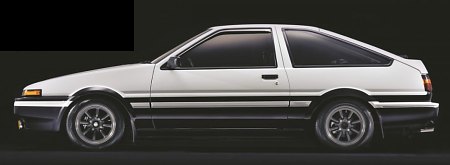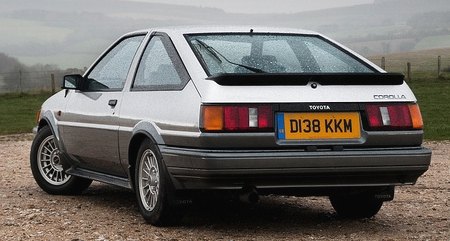 In 1983, Toyota launched a
pair of affordable coupes in Japan. Their official names were Corolla
Levin and Sprinter Trueno. They were basically the same car except some
cosmetic differences – the Levin employed a conventional front end
while
Trueno opted for a slant nose and pop-up headlamps. In overseas market,
the cars were badged as Corolla GT Coupe instead. However, most people
simply called these cars AE86 after their
internal codename.
Many young car enthusiasts knew the AE86 from Initial D. Without this popular Japanese anime, it would not have attained a mighty status a decade after its extinction. Back in the mid-1980s, the AE86 was more a kind of unsung hero. Compared with MR2, Mazda RX-7, Mitsubishi Starion or Nissan 300ZX, it was rather understated. It didn't look especially eye-catching with a neat and boxy styling. Nor did it made headlines with its old-fashioned FR layout and live-axle rear suspension, which were apparently adapted from the last generation Levin. Toyota could have changed it to FF and all-independent suspensions like the rest of the Corolla family, but it determined to keep a classic handling characteristic for the coupe. Fortunately, now we know that was a correct decision. The AE86 became the very last rear-drive cheap coupe produced in Japan, and it was one of the most exciting ever made.  Another great asset was the brand-new 4A-GE engine. This 1587 cc twin-cam inline-4 was the earliest mass production 4-valve engine in the world (note: when I say "mass", I really mean mass). It was capable of revving to 7700 rpm, while its T-VIS variable intake system enabled a stronger mid-range torque that would be normally incompatible with such a high-revving engine. Output was rated at 130 hp in Japan or 124 hp in Europe (American version dropped to 112 hp due to emission control), significantly more than any European production motors of the same size. It allowed 120 mph flat out and 0-60 mph in about 8.5 seconds, again remarkable for a 1.6-liter coupe. For comparison, an Alfa Romeo Sprint hit just 110 mph and took 2 more seconds to go from 0-60. A light clutch, slick gearshift and 5 closely stacked ratios also helped the driver to use the high-revving engine to the fullest.  However, the AE86 was not a car for everybody. Its engine
was noisy at high rev. Its ride was quite hardcore. A lot of suspension
and road noise could be heard in the thinly insulated cabin. The
live-axle was prone to axle tramp at times, and the handling could get
nervous on wet roads. These negative factors offset the relatively
spacious cabin, excellent driving position, supportive seats and good
visibility, giving some European magazines a good excuse to call Opel Manta a better coupe for
everyday driving. In my opinion, they were as different as apple and
orange. It goes without saying that the Toyota was strongly oriented to
hardcore drivers.
The car got a mild revision in 1985, including 14-inch alloy wheels, beefier 195/60 tires, retuned suspension geometry and speed-sensitive power steering. Levin received a more conventional louvered grille. The engine was tuned to deliver peak torque a little earlier, too. However, the strengths and weaknesses remain largely unchanged. Following its demise in 1987, Toyota would turn the Levin / Trueno into front-wheel drive. They might get more powerful and faster in straight line, but the direct feel and interactive chassis response would not return. Fans of Toyota and Japanese affordable coupes would miss these qualities until the birth of new 86 (GT-86) some 25 years later, but that would be another story.  |